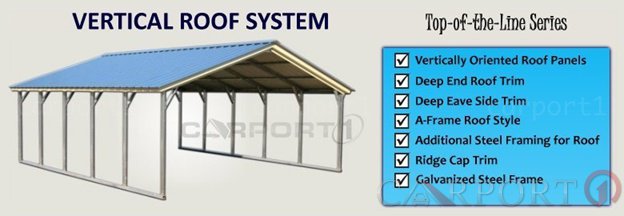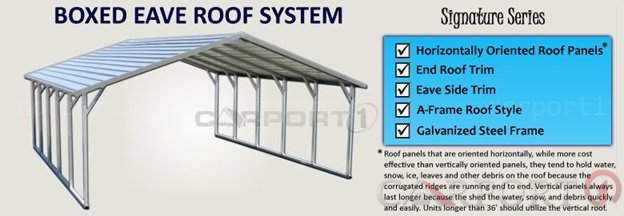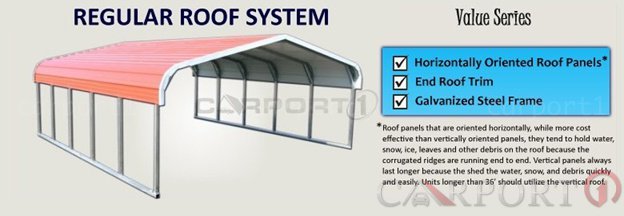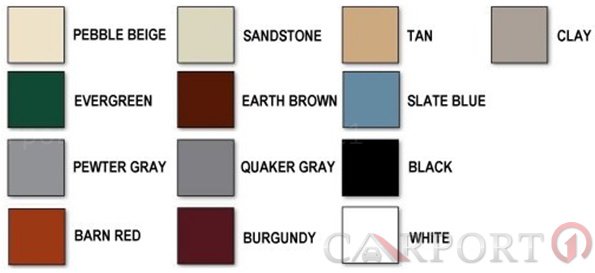Frequently Asked Questions
General
Our standard service area includes the states of Alabama, Arkansas, Florida, Georgia, Illinois, Indiana, Iowa, Kansas, Kentucky, Louisiana, Maryland, Michigan, Mississippi, Missouri, New Jersey, New York, North Carolina, Ohio, Oklahoma, Pennsylvania, South Carolina, Tennessee, Texas, Virginia, West Virginia.
We offer three roof styles. They are:
Regular style units have rounded corners and are considered the “basic” of carport designs. Acting as a founding product for all other designs, the regular style unit is typically the most economical and affordable product.
Boxed Eave units are designed with an “A” frame roof truss and horizontal roof panels. This modern design has made this style of unit one of the most popular available. An upgrade to Boxed Eave style is both stylish and affordable.
Vertical Roof units are designed with an “A” frame roof truss and vertical roof panels. Hat channel runs the length of the unit to cross brace the roof and provide a mounting point for the roof panels. This design helps to prevent weathering elements such as rain and snow from “standing” on your building. Vertical Roof units come standard with a ridge cap and are specially designed with wider trim that gives the product a modern, finished appearance. for more information about our roof styles visit our roofing systems page.
Yes. For example you may need a unit that is 23′ wide x 24′ long. We will customize it to that size.
Yes, units are available for drop-off only. All materials will be delivered to your location. No assembly instructions are provided. We highly recommend that you have your unit installed by professional contractors.
Certified buildings are engineered to meet a specific snow and/or wind load. Many areas across the country, particularly in the northeast and along the coastal regions, require that the buildings meet a specific wind or snow load. You should be aware of your area’s requirements and purchase a structure that meets the wind and/or snow load requirements for your state. We service a wide territory and since requirements change from area to area. It is your responsibility to know the requirements and to purchase a structure accordingly!
Federal and state governments are tax exempt. You must pay sales tax unless you reside in a tax-free state or can provide a copy of your agricultural or sales tax exemption.
Common Specification Questions
- Units installed over an existing structure or over an obstruction
- Trip charges will apply for installations outside of our standard service area and could apply toward outer edges of service areas
- Installation on unleveled sites
- Installation on a non-floating boat dock. We do not install units on floating docks
- Installation on an elevated retaining wall – fees are assessed on a case-by-case basis
- Materials that have to be transported by foot over 50 feet to the installation site
14 gauge units come with a 90-day limited workmanship warranty. 12 gauge carports come with a 20-year warranty against rust through the frame, assuming standard care and maintenance are applied. Also a 90-day limited workmanship warranty is included for 12 gauge products. There are no other warranties stated or implied. Additions, modifications, and alterations void all warranties.
29 gauge sheet metal is standard for most states except Florida. In Florida, 26 gauge sheet metal is used for 150/180 MPH certified units and is standard on all units in Florida. Outside of Florida, customers can upgrade to 26 gauge sheet metal for an additional charge. Contact us for more information.
Panels are 3′ (three feet) wide
Units are available in any length.
You may need a permit, depending on your state regulations, local zoning laws, or rural location. Customers are responsible for permits
No, we will not attach our steel structures to other structures due to insurance liabilities
No, we do not offer rain gutters
Delivery and installation are provided by independent contractors
Call our knowledgeable staff at the locations listed on our Contact Us page.
Ordering
Our building measurements are Width x Length x Height. For example: An 18’ x 21’ x 6’ building’s base frame size is 18’ x 20’ x 6’. The roof metal overhangs 6” on each end so the bottom base rail frame dimension is one foot shorter than the roof. The width is measured from the outside of the baserail to the other outside of the baserail.
14 gauge galvanized steel framing measures 2 1/2″x 2 1/2″; 12 gauge galvanized steel framing measures 2 1/4″x 2 1/4″
Both are galvanized steel. However, the wall thickness of the 12 gauge framing is 3 hundredths of an inch thicker.
You should pour your cement exact to the width and 1’ shorter than the roof. In Florida, the cement should be ¾” wider than the width and 1’ shorter than the roof. For Example: In all states except Florida, the slab for a 18’ x 21’ x 6’ unit needs to be 18’ x 20’. In Florida, the slab for the same unit needs to be 18’ ¾” x 20’. Keep in mind if you need a building permit, you will need to contact us for the slab specifications as they vary from area to area.
14’ is the highest side height that is offered in the majority of our service areas. We do offer 20’ tall units in some areas. Please call for your specific area.
To insure proper installation, your site should be level. For carports, we can work with an unleveled job site if it is no more than 3” off level. For garages, the site should be level as garage doors will not properly closed on unleveled sites.
In most cases, Yes. There may be a minimum service charge of $50 or more on all return trips. Be advised that we will only add to buildings that we have installed and delivered. If you do not know who manufactured your unit, it’s unlikely that we can add to it. Our roof pitch, panels, and trims may not be compatible with your existing unit.
We have four different types of anchors. They are:
- For non-certified ground/asphalt installations, 32” rebar anchors. This is our standard ground anchor for all non-certified units
- For ground/asphalt installations that are certified, double helix mobile home anchors are used. These anchors can be used on non-certified ground installations at an additional charge and they are recommended
- Lag bolts for wood installations. Be advised wood installations cannot be certified
We partner with numerous manufacturers across the United States and because of that, we know the best product that’s suitable for what you need. We factor in quality, price, certification, and delivery schedules to get you the best product, at the best price, in a timely manner. Because of our volume and our extensive expertise and experience, we are far more knowledgeable than your local, part-time dealer.
Carport1's ordering process is simple and straightforward. Whether you are purchasing your building online or you’re working with one of our knowledgeable representatives, the process is essentially the same.
Once you have selected the building that you need, a down payment is required to begin your order. For orders under $1500.00, a down payment of 10% is required. For orders that are $1500 – $4000.00, a down payment of 12% is required and for orders more than $4000.00, a 15% down payment is required.
To expedite your order, payment can be accepted using VISA, MasterCard, Discover, American Express, and PayPal. We can accept company or personal checks but those checks must clear, usually requiring 5-10 business days, before your order is processed. We can accept purchase orders and those should be submitted to us for approval.
Usually 2-4 weeks from the date that you are ready to have your building installed. If your order is received and you are not ready, the 2-4 week window begins when you are ready to take delivery of your building. Do keep in mind that during the summer and early fall, delivery windows may increase based on customer demand (remote areas make take longer). For the most accurate delivery windows, please call us as the demand for our products varies from season to season.
Yes, as long as you are within our standard service area, the job site is clear of any obstructions, and the installation site is level. On larger buildings, wider than 30’, you may be required to provide a telescopic boom lift at the job site in order for us to set the trusses. For most units, a lift is not required.
Of course! Keep in mind that adding additional options will increase the price and by the same token, removing options will lower the price. As for the colors, you can choose any color that we offer and there’s no additional up-charge for any of the colors that you select.
You can change your order up until the time that we have you scheduled for delivery. At that point, it’s probably loaded on a truck and is ready to deliver. Adding options will increase the price and removing options will lower the price. It’s never a problem to work with you if your needs change, as long as we know in a timely manner.
Construction Questions
Remove anything out of the way that would impede the progress of the installation. Clearly mark the four corners of the carport location and level the site.
For all units, the roof pitch is approximately 3:12.
Yes, for non-certified units only. Additional fees may apply.
We will only install on a stationary dock. We will not under any circumstances install a carport on a floating boat dock. We must be able to unload the truck and trailer near the boat dock without carrying materials over 50 feet or up/down steps. There must be a 3’ unobstructed access on all sides to the dock.
The clearance is approximately the 3″ less than the side height.
Anchoring Questions
On non-certified units, 32″ long rebar anchors are inserted through pre-drilled holes in the base rail. The anchors are driven into the ground with a sledgehammer for a secure hold. On certified units, double helix mobile home anchors are augured into ground and a bolt is inserted through pre-drilled holes in the side of the base-rail. The bolt is secured with a nut. Mobile home anchors are an optional upgrade for non-certified ground installations and they are always recommended.
Holes are drilled into your concrete slab. Wedge anchors are inserted through pre-drilled holes in the base rail of your unit into the holes in the concrete and fastened for a secure hold.
For non-certified units, 32″ long rebar anchors are inserted through pre-drilled holes in the base rail. A small hole is made in your asphalt and the anchor is driven into the ground with a sledgehammer into the asphalt. For certified units, we must install double helix mobile home anchors that are augured into ground.
Lag bolts are inserted through pre-drilled holes in the carport base rails and screwed down into the wood surface for a secure hold.
We will only install on a stationary dock. We will not under any circumstances install a carport on a floating boat dock. We must be able to unload the truck and trailer near the boat dock without carrying materials over 50 feet or up/down steps. There must be a 3’ unobstructed access on all sides to the dock.
Buyers Guide – FACTORS TO CONSIDER
If a building permit is required, then your building inspections department will require a Engineer Certified unit that is rated for wind and/or snow load.
That might sound like a silly question but we can better assist you with your selection if we know how the unit will be used. You may plan to store a single car, two or more cars, a boat, in an open carport shelter, or just use the unit for an economical shed for farm equipment. You may need an enclosed garage for secure storage or a barn for livestock. Once the purpose is known, we can make recommendations on width, height, length, style, and other options. Our goal is to provide you with the best solution that works at the lowest possible price.
That’s easy, “On my property,” right? There is just a little more to it than that. You may already be aware of these suggestions but in case you haven’t considered them, here they are. Please ensure that you site is clear of any property line set-back restrictions, clear of any underground utilities, overhead utilities, drainage/sewage lines, trees, etc. We don’t like surprises and we are sure that you don’t either. It would be a surprise if the unit was installed 1′ over on the neighboring property or our anchors pierced a water line or cut the cable lines to your home wouldn’t it?
The job site should be level and free from obstructions. An unlevel job site (greater than 4″) will not give you the ideal results. If the carport job site is greater than 12″ off level, our installation crews cannot install the unit.
We install on the ground (dirt or gravel/stone), asphalt, concrete, or wood. Be advised that certified units cannot be installed on wood.
The next step in selecting your unit is choosing unit roof system. We have three types of roof systems and they are defined and illustrated below. Using our Roof System Guide, you will have all of the information that you need to make the choice that’s best for your needs and for your budget.
We offer three roof systems from which to choose. They are the Vertical Roof System, The Boxed Eave Roof System, and the Regular Roof System. Each roof system has both advantages and disadvantages in regard to function and cost.
- The Vertical Roof is the best roof system that we offer. The panels on the roof are oriented with the corrugated ridges running vertically or up and down much like what you would see on a metal home roof. It stays cleaner and lasts longer than panels oriented horizontally. Pollen, leaves, and other debris easily wash off the roof with a hard rain. Snow also moves better off the vertical roof system. With the additional steel and trim components used to create the vertical roof, the disadvantage to owning this roof system is that it is the most expensive roof system.

- The Boxed Eave Roof has the A-Frame appearance of the vertical roof but the panels are oriented horizontally. Horizontal panels tend to trap leaves and debris on the roof. The roof will not stay as clean as the vertical roof and the panels will not last as long. While it has the appearance of the vertical roof in shape, it does not have the ridge cap trip, steel hat purlins, and deeper trim that the Vertical Roof System has. The absence of those components makes this roof system less expensive than the vertical roof system.

- The Regular Roof does not offer the A-Frame appearance as the two previous roof systems. The panels are oriented horizontally on the roof and the unit has a bend transition to the legs compared to a welded transition on the Vertical and Boxed Eave Roof Systems. The primary advantage to owning this roof system is cost. This is our most economical roof system.

Carport1 offers 2 thickness choices on the galvanized framing systems. Our standard is a 14 gauge frame, which is .0747 inches/1.897 mm thick. We offer a heavier 12 gauge frame that is .1046 inches/2.657 mm thick. Either frame system can be non-certified or engineer certified. The is an extended warranty on our 12 gauge framing system and it is a stronger frame.
Which is best for your application? Ultimately, the decision is yours. If you want the peace of mind with the extended warranty and/or the stronger frame, then the 12 gauge is the way to go.
The dimensions of the unit (width, length and height) are based on your need and what the planned use or function of the unit is going to be.
Width Guide
- 12′ wide is good for most single vehicle
- 18′ wide – (2) compact cars
- 20′ wide- (2) mid-size cars
- 22′ wide – (2) full-size cars
- 24′ wide – (2) large vehicles
- 30′ wide – (3) vehicles
Length Guide
Standard lengths are 21′ 26′, 31′, 36′ and longer in 5′ increments. 21′ and 26′ long are ideal lengths for two cars. RVs, boats, campers, etc. will require longer units. A good best practice is to consider the length of your unit and add 5′ to determine the minimum carport length.
Side Height Guide
The side height is measured on the side wall and not at the center or apex of the unit. You will want to ensure that the unit’s side height is tall enough for your car, truck, camper or RV. Should you ever plan to enclose the unit, add enough space for garage door height and clearance.
If you are unsure about any of the dimensions, call us and one of our experienced team members can assist you in selecting the right one for your needs.
With carports, there are several available options.
Side Walls
The sides can be left open or one or more panels can be placed on the side wall, or the side can be closed to the ground for additional protection from rain and sun. Also, adding panels to the side walls makes the carport more rigid and strengthens the unit, end-to-end.
End Walls
The end walls can be left open or have optional gable ends, extended gables, or can be closed to the ground. Gables add to the appearance of the unit, hiding the roofing framework. They also provide additional shelter on the ends of the unit as well as make the structure stronger and more rigid, side-to-side
J-Trim
Panels on the side walls and gables on the end wall are left un-trimmed on the bottom. J-trim can be added to the bottom of the panels for both appearance and for safety. We recommend J-trim on any panel edge that is 3′ – 7′ in clearance height and will be exposed to foot-traffic.
With garages, there are several available options in which to customize your unit
Garage Doors
we offer roll-up doors up from 6’ wide to 6’ tall to 12’ wide x 12’ tall.
Walk-in Doors
we have 36” x 80” walk-in doors, with or without windows in the door
Windows
all single pane in 30” x 30”
Interior Walls
we can customize units by adding interior walls across the width of the unit or down the length of the unit
Porches/Overhangs
we can create open or partially enclosed porches on the ends of your unit
Lean-tos
we offer lean-tos that are attached to the center or main structure, up to 12’ wide
For the majority of our service area, the color sections at the right are available. In limited areas, there are a few more color choices. IF you don’t see the color that you want, call one of team members and they can advise as to whether a specific additional color is available in your area.

For carports and garages, the available colors choices are for:
- Roof Color
- Trim Color
- Side and End Wall Color
These options are available for no extra cost!
Here are our color selections
You may coordinate your colors by using our color planner tool





